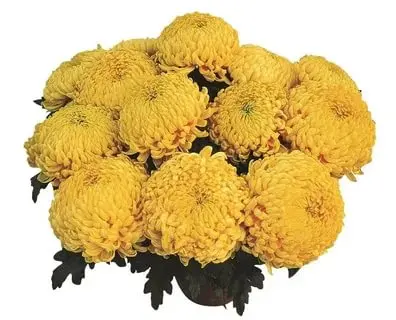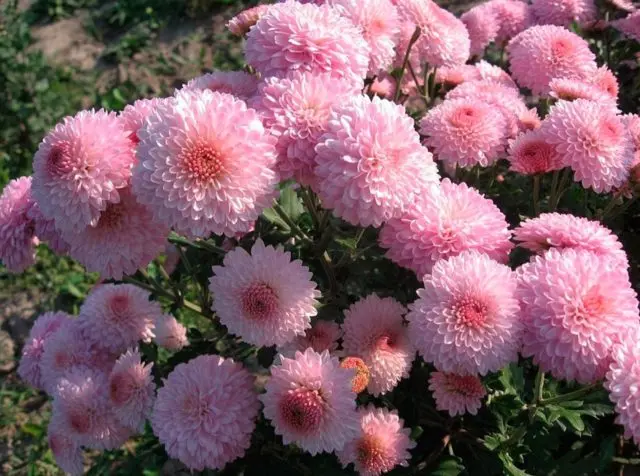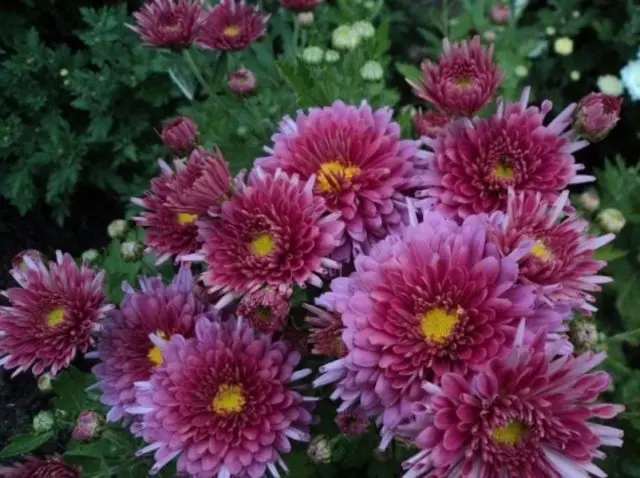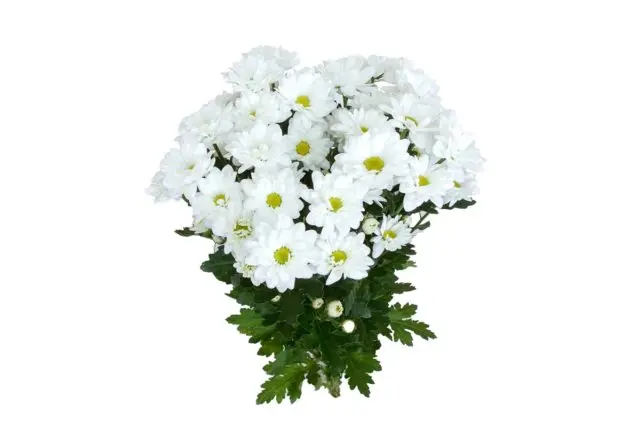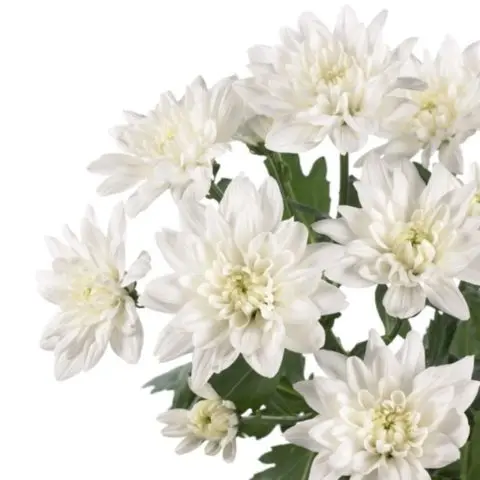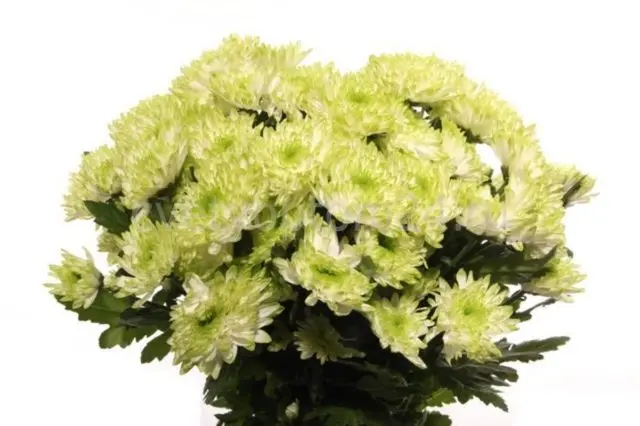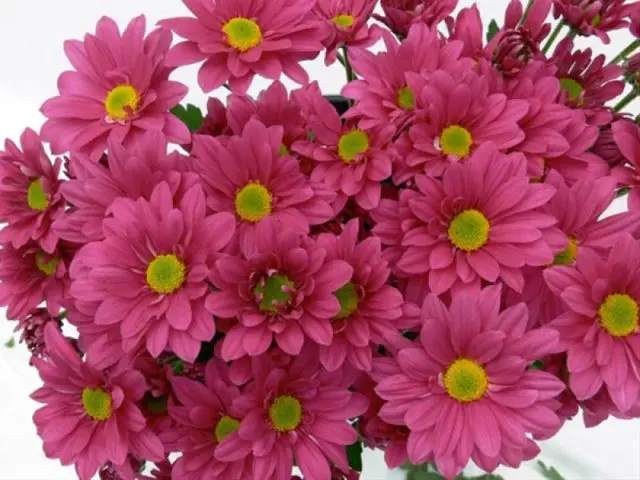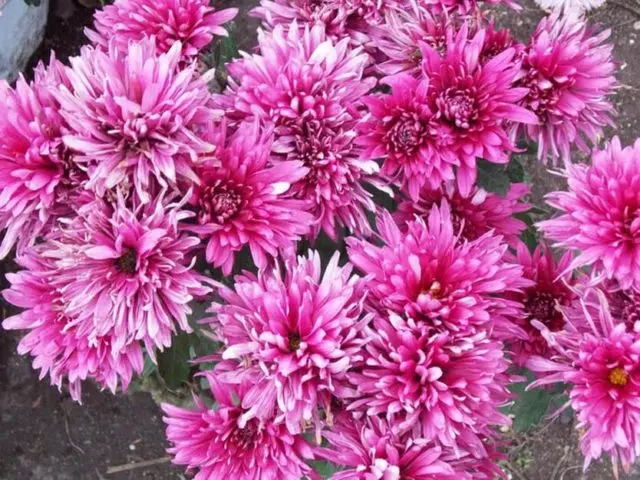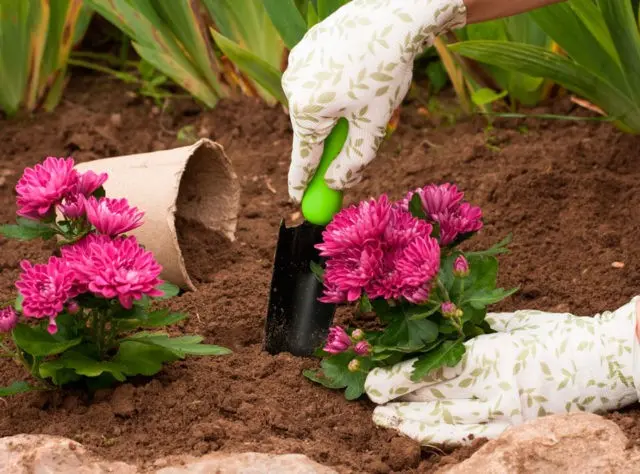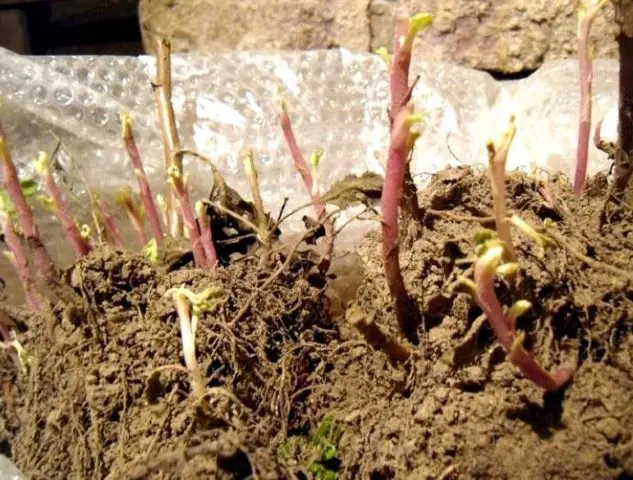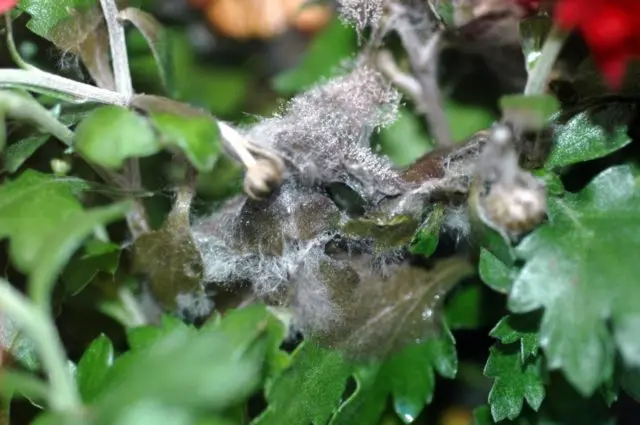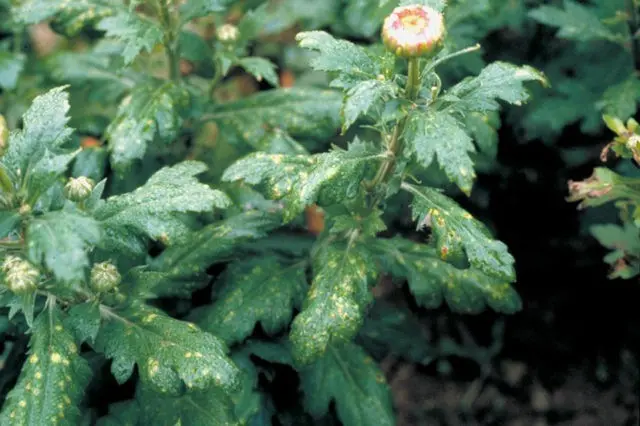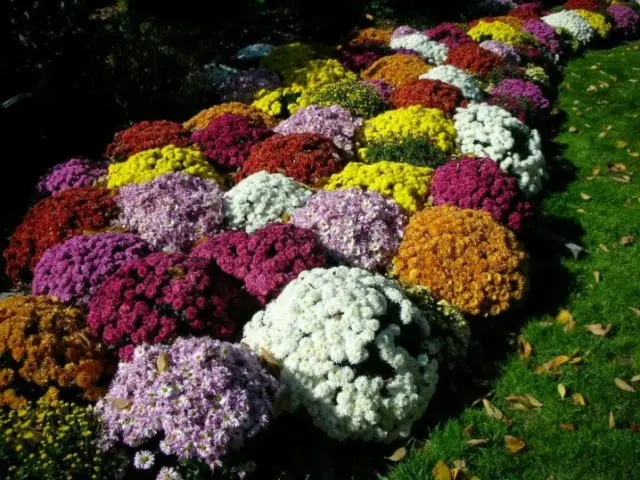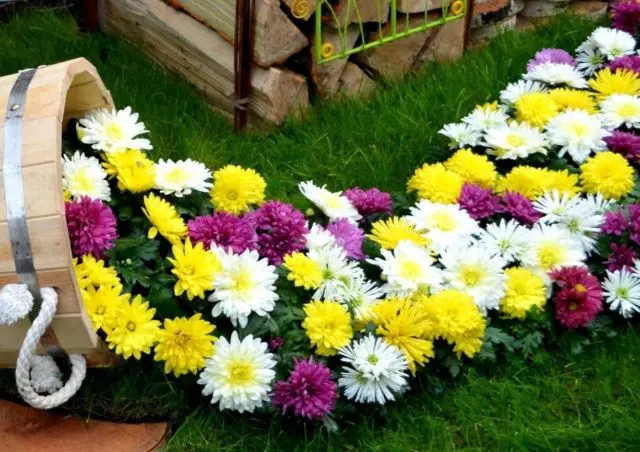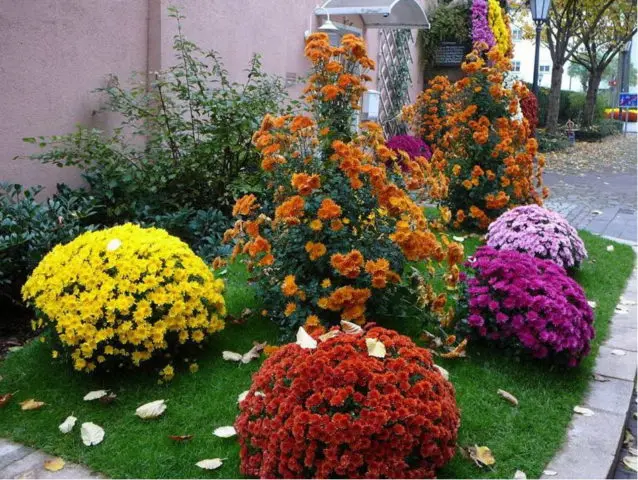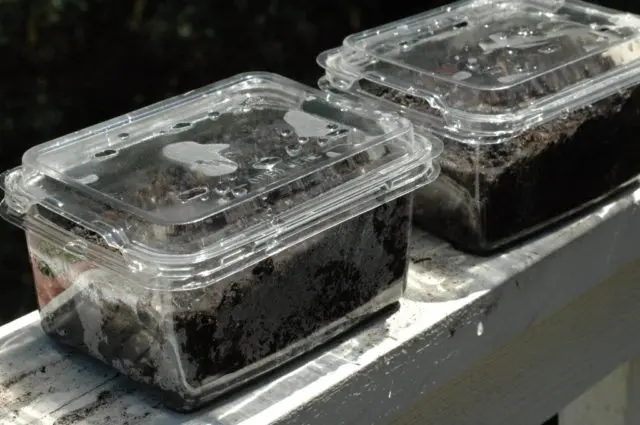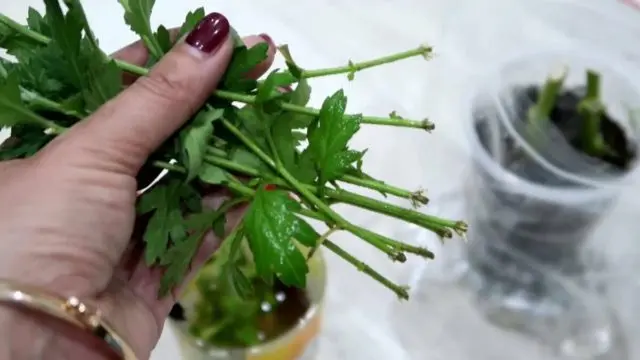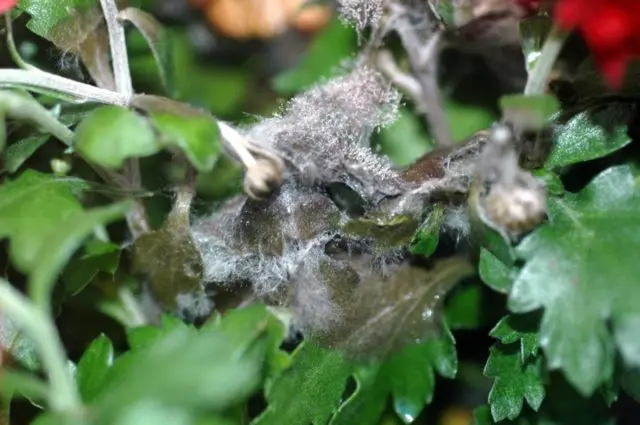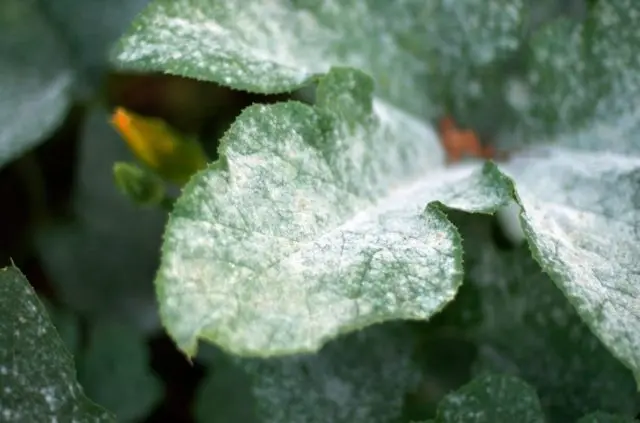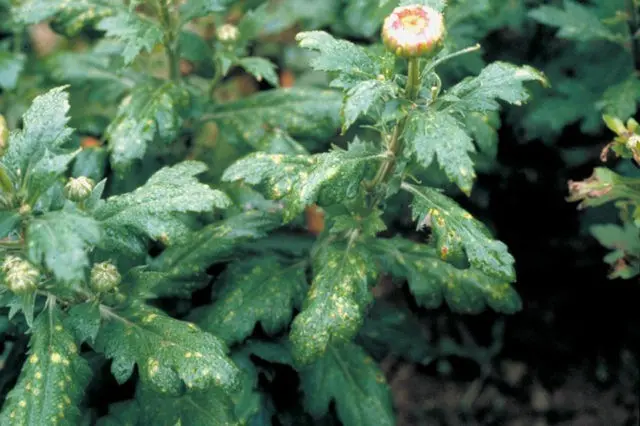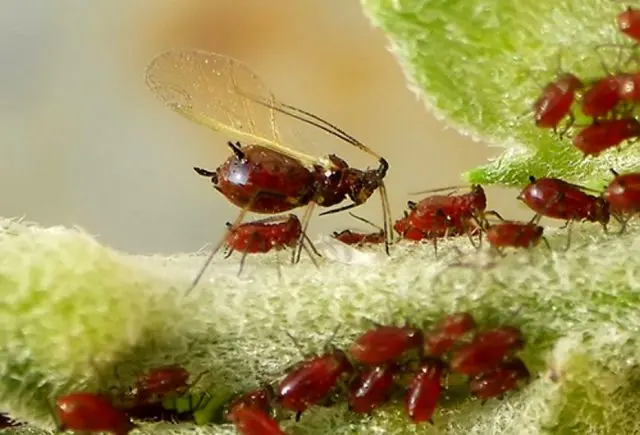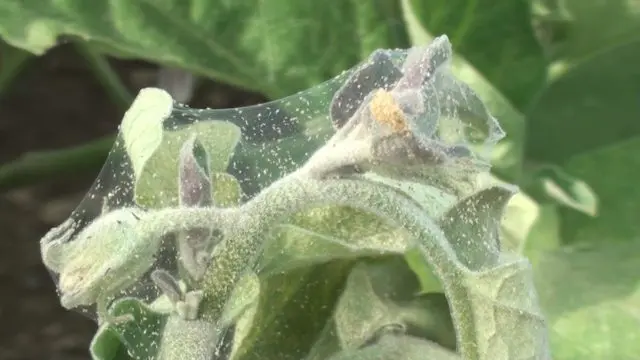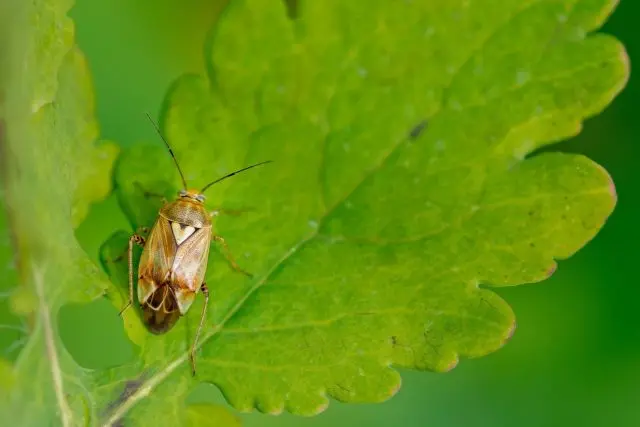Contents
- What do chrysanthemums look like?
- When planting bush chrysanthemums
- Varieties of spray chrysanthemums
- Bush chrysanthemums in landscape design
- Planting and caring for spray chrysanthemums
- How bush chrysanthemums winter
- Reproduction of spray chrysanthemums
- Diseases and pests of spray chrysanthemums
- Photo of spray chrysanthemums
- Conclusion
Bush chrysanthemum is a favorite “tool” for many landscape designers. These perennial flowers come in a huge variety of species, varying in size, color, flowering time, so they can be used in many flower arrangements. In addition, these plants are quite unpretentious, so they are grown in various regions.
What do chrysanthemums look like?
Bush chrysanthemums are perennial herbaceous plants of the Aster family (Compositae). Numerous erect shoots form a rounded bush 0,3-1,5 m high. The root of the plant is well developed, fibrous. Stem leaves, in the lower part on short petioles, strongly dissected. Their size depends on the type and variety of the plant. The leaf plate is green, on the reverse side of a grayish tint, slightly pubescent or bare.
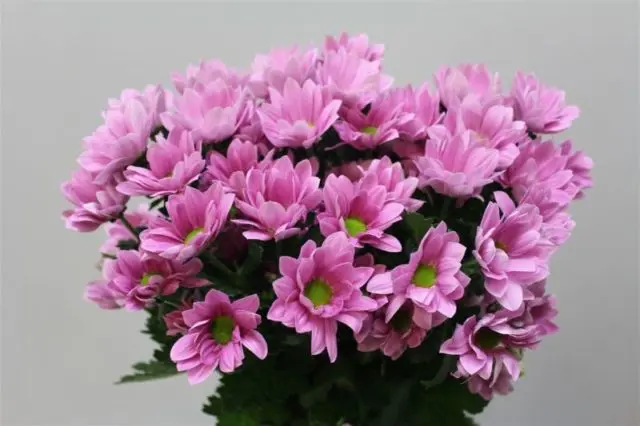
Spray chrysanthemums are versatile in their use in the garden
The flowers of the chrysanthemum bush are bisexual, tubular and reed, numerous, collected in inflorescences-baskets located at the ends of the shoots. The structure and size of the inflorescences depends on the variety. Flowering of spray chrysanthemums begins in July and ends only with the first frost. The color and color of the petals is very different, from white to purple.
When planting bush chrysanthemums
Seedlings of spray chrysanthemums grown from seeds or bought in a store are planted in open ground quite late, at the end of May or in the first half of June. Such late dates are explained by the fact that young plants are very vulnerable to return frosts.
Varieties of spray chrysanthemums
All spray chrysanthemums are usually combined into several large groups in accordance with their characteristics and appearance:
- simple and semi-double;

These are varieties with an open middle of a flat inflorescence that look like chamomile.
- anemone;

The inflorescences of these varieties also have an open middle, but it has a more convex shape.
- feathery;

Varieties of this group have terry inflorescences, while the flower petals completely cover the middle of the flower
- bristly;

Visually reminiscent of a round brush, inflorescences resemble a pinnate group, however, the petals are less densely spaced
- pompoms;

The inflorescences of this group of spray chrysanthemums are spherical, regular in shape.
- spoon-shaped;

This group got its name because of the characteristic shape of the petals, expanding in the form of a spoon towards the end.
- fantasy, a young group of spray chrysanthemums from Japan;

By the type of inflorescence of this group they coincide with pinnate, but they have much longer petals.
Below are some of the most popular varieties of perennial spray chrysanthemums most commonly used in ornamental gardening and landscaping.
Alice
A low variety of spray chrysanthemums, grows up to 0,35-0,4 m. The bush is round, dense, the shoots are densely leafy. Alice belongs to the group of semi-double Korean chrysanthemums. The flowers are about 3 cm in diameter, bright yellow. Flowering begins in late July or early August and continues until September.
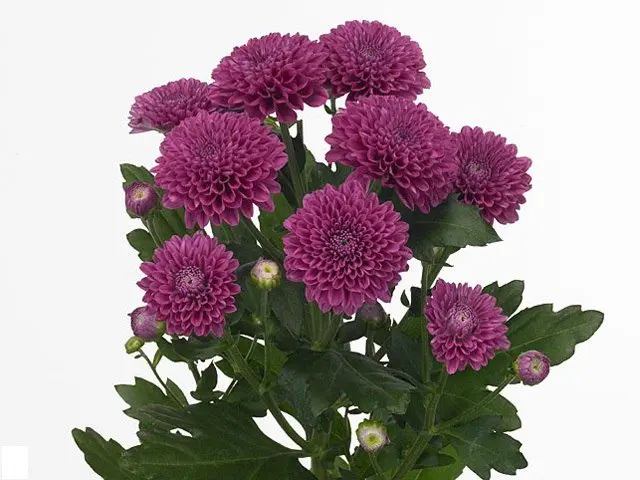
Alice looks great as a separate bush
Bacardi
This is one of the late flowering varieties. Its distinctive feature is the green or light green middle of the flower, while the petals can be white, pink, yellow. The inflorescences themselves are quite large, their diameter can reach up to 10 cm. The spray chrysanthemum Bacardi blooms at the end of summer and pleases the eye throughout September. Bush of medium density, up to 0,5 m in height. Shoots are hard, dense.
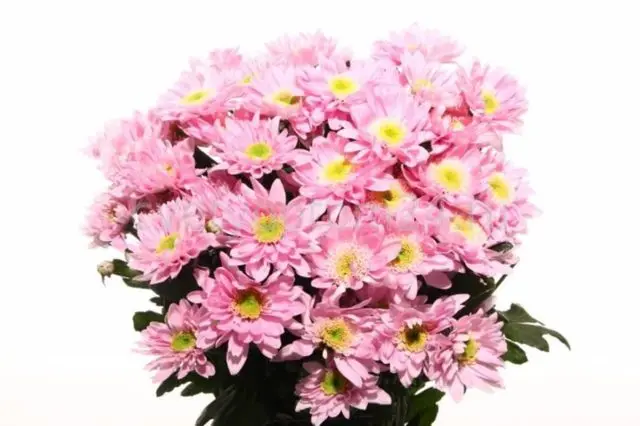
Bacardi is widely used for various bouquets
The Baltics
This variety is especially popular with flower growers, since the flowers can be used both for decorating the backyard territory and for flower bouquets. Shoots 65-85 cm long, form a rounded bush of medium density. On each of them, up to 3 terry inflorescences of various colors with a diameter of 12 to 20 cm can ripen. The spray chrysanthemum Baltica blooms all autumn until the frost.
There are several varieties of chrysanthemums of the Baltic variety, differing in color and size of inflorescences.
- Baltic Pink – pink.

- Baltic White – white.

- Baltic Lilac – purple.

- Baltic Lime – light green with a greenish-lemon edging.

- Baltic Yellow – yellow.

- Baltic Purple – purple.

- Baltic VIP – white with purple or red streaks.

Bush varieties Baltika are excellent cut, retaining their decorative effect for several weeks. They are often grown as potted plants.
Lollipop
The length of the shoots of this variety of spray chrysanthemums reaches 0,7 m. The inflorescences are of the pompom type, rather large, 6-7 cm in diameter. The color of the petals is lilac-violet. Bush chrysanthemum Lolipop blooms in September-October. The flowers have a pleasant herbaceous aroma, are excellent cut, retaining an attractive appearance for up to 3 weeks.

Mona Lisa
A popular variety of spray chrysanthemums, widespread among gardeners. The shoots are long and strong, the height of the bush can reach 1,5-1,7 m. This is one of the largest varieties with simple inflorescences.
It has several varieties:
- White. Inflorescences with white petals, the central part is green.

Flowering begins in September and ends only with the arrival of frost.
- Pink (Pink). Pale pink petals contrast well with the yellow-green center of the flower.

Pink inflorescences can be up to 8 cm in diameter.
- Cream. Cream-colored petals, the central part is greenish-yellow.

A creamy look blooms all autumn with beautiful inflorescences up to 7 cm in diameter
Reagan
The height of a bush of these chrysanthemums can reach 0,7-0,9 m. Inflorescences with spoon-shaped petals up to 10 cm in diameter. Flowering begins in August and ends at the end of September. Inflorescences consist of yellow, red or orange petals, the central part is yellowish green.
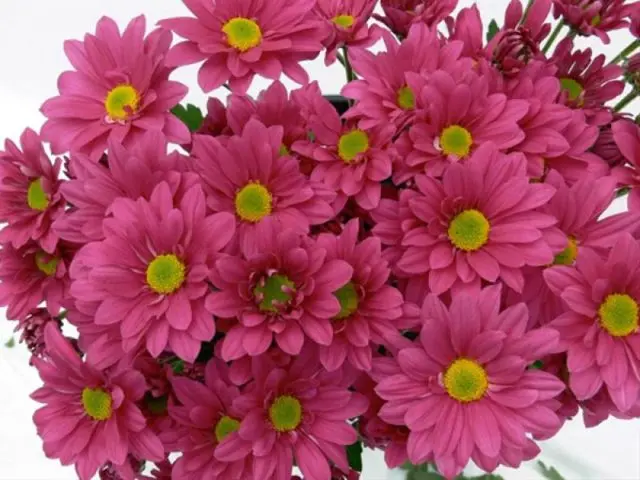
Reagan features spoon-shaped petals
Saba
Chrysanthemum Saba can grow up to 70 cm, forms a beautiful bush with very original inflorescences with a bright green center and two-colored petals bordered around it. The stem of the plant is strong, the foliage is medium.
Flowering begins in September and continues until mid-October. There are several colors of spray chrysanthemum Saba: lilac-white, yellow-orange and many others.
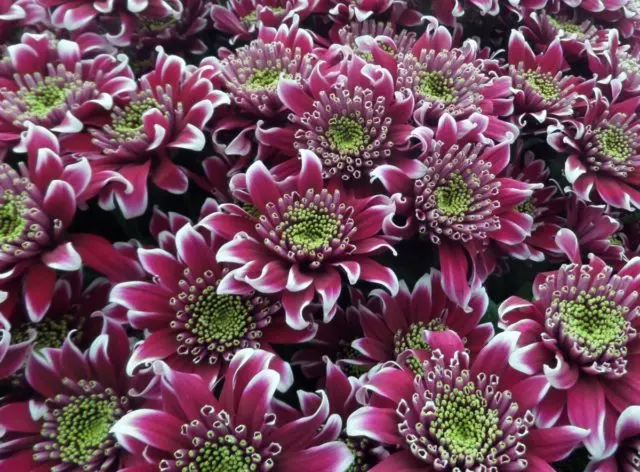
Saba have an unusual two-tone color of the petals.
Minx
This variety of Korean spray chrysanthemums has a pinnate inflorescence. The color of the petals is dark red, burgundy or purple. The diameter of the inflorescence ranges from 5 to 10 cm. The flowering period is September. The bush is not very tall, the length of the shoots is 0,5-0,7 m.
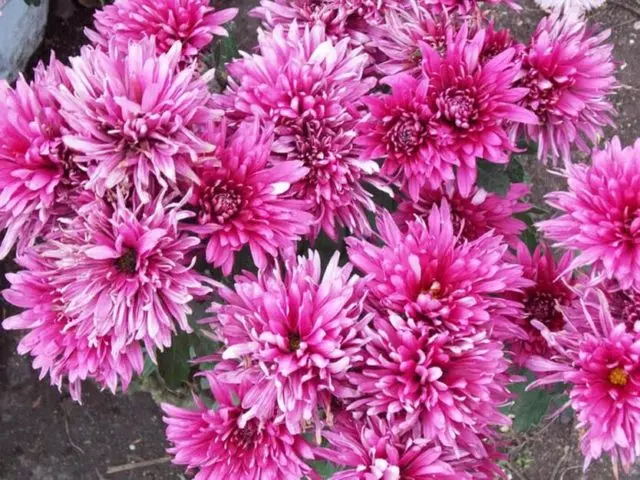
Minx – a representative of Korean bush flowers with a feathery inflorescence
Bush chrysanthemums in landscape design
The rather late flowering period of spray chrysanthemums allows them to be used to decorate household plots and landscape gardening areas in the fall, when many ornamental plants have already faded. Traditionally, low varieties are used by landscape designers as border plants, planting them as part of mixborders along the walls of buildings, paths and alleys, and also as a colored background.
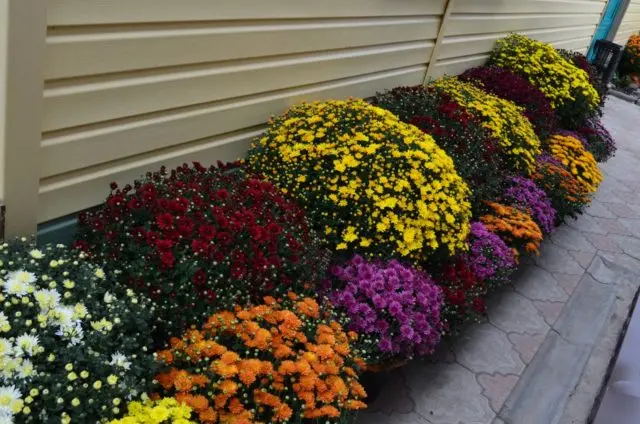
A colorful border of spray chrysanthemums looks great
Larger bushes are used as color and architectural accents in group or individual plantings.
Planting and caring for spray chrysanthemums
Some species of these plants are tolerant of the climate and feel good in open ground. However, some varieties of spray chrysanthemums, especially large-flowered ones, for example, in the Moscow region are best grown as potted ones, putting them indoors for the winter and putting them back in the garden in the spring. In general, caring for them is quite traditional and not particularly difficult.
Where to plant bush chrysanthemums
These flowers love good but diffused lighting. In the shade, they grow worse, stretch out strongly and may not even bloom. These flowers do not like open spaces where they can be damaged by the wind, the best place for them is closed areas or areas near fences, walls of buildings, structures. The soil requires breathable, loose, rich in humus. Clay areas and places where water stagnates are not suitable for chrysanthemums.
Rules of landing
Planting of plants is carried out by seedlings obtained from seeds or grown vegetatively. The earth must be dug up in advance, adding humus, as well as urea and superphosphate. Seedlings can be planted on any cloudy day, from May to mid-June, after the risk of returning frosts is minimal and the soil has warmed up sufficiently.
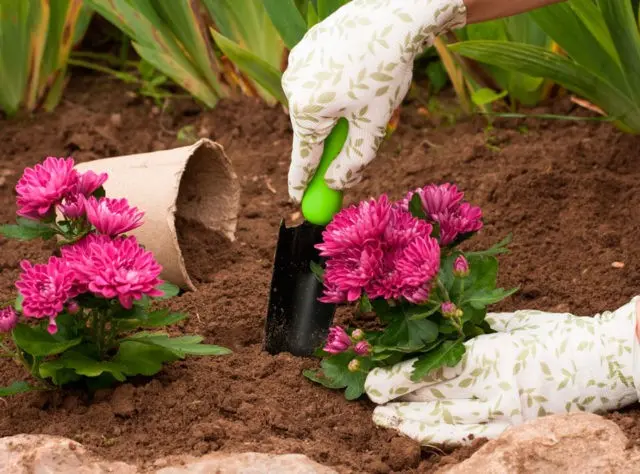
For planting chrysanthemums, it is convenient to use a small metal spatula.
For planting seedlings in open ground, it is better to use a small iron spatula. Be sure to stock up on well-marked pebbles for laying drainage – stagnant water in the roots can lead to the death of plants. Using a spatula, you need to dig out the landing holes, pour a layer of pebbles into them. Then seedlings are planted, while they are not deepened. Immediately after planting, the plants are pinched to increase the survival rate of the roots. The distance between adjacent seedlings is chosen based on their variety and size of future chrysanthemum bushes. If their size does not exceed 0,5 m, then the interval between adjacent plants should be 0,2-0,3 m, the interval between large bushes should be at least 0,5 m.
If for some reason the spring planting failed, then the procedure can be repeated in the fall, at the end of September or at the beginning of October. Most often, this need arises when planting a bush by dividing, when each part of it actually becomes an independent plant. Be sure to wait until the end of flowering, otherwise the chances of success of this procedure will decrease dramatically. After planting in autumn, spray chrysanthemums need special care, they need to be mulched with peat, and before frosts, be sure to cover them with non-woven material.
Watering and top dressing
Spray chrysanthemums equally dislike both excessive watering and lack of moisture. In the first case, the roots rot in the plants, and in the second, the inflorescences become smaller, the shoots become thin and stiff. Spray chrysanthemums are watered moderately, under the root, with settled or rain water. Better to do it in the evening. In hot weather, after sunset, you can periodically do sprinkling plantings. This will remove dust from the leaves and return them to a bright green color.
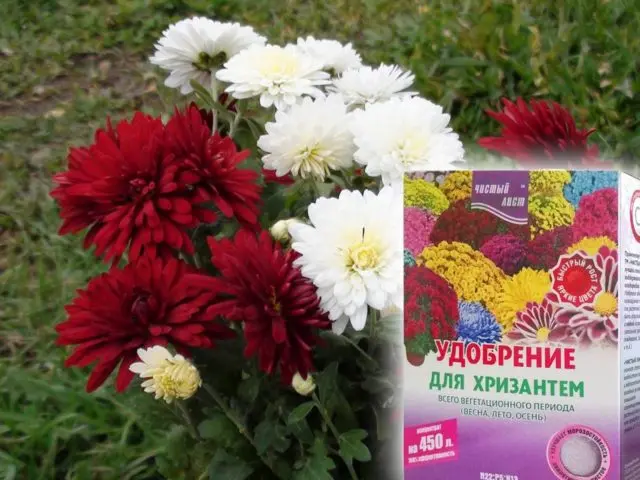
Specialized fertilizers for chrysanthemums replace traditional mineral fertilizers
In the spring, bush chrysanthemums are usually fed with urea, making it in the form of an aqueous solution. During the season, you can use a solution of slurry for feeding 2-3 times. Starting from mid-summer, the application of nitrogen-containing fertilizers is stopped. At the end of summer or autumn, complex mineral fertilizers containing potassium and phosphorus are applied.
How bush chrysanthemums winter
In regions with warm winters, bush chrysanthemums winter well under minimal shelter. Before wintering, all shoots are cut at a height of 10-15 cm from the ground, spud, and then the plants are covered with a thick layer of fallen leaves or straw, covered with spruce branches. In cold regions, the bushes are dug up together with a clod of earth on the roots, put into boxes and stored in the basement at a temperature of + 2-5 ° C.

In cold regions, it is better to dig up bush chrysanthemums for the winter and put them indoors.
Potted and indoor chrysanthemums are also cut before winter and stored in a cool room. During wintering, the plants rest, no manipulations are carried out with them, with the exception of a rare moistening of the soil to prevent complete drying of the roots.
Reproduction of spray chrysanthemums
For propagation of spray chrysanthemums, you can use the seed method, as well as one of the vegetative methods:
- Seed method. It is rarely used in ornamental gardening, because it is long, and the resulting seedlings do not always retain their parental varietal characteristics. Most often, the seed method is used by breeders when breeding new varieties. Planting is done in January. For growing seedlings, a container filled with special soil is used. Seeds are distributed over the surface of the soil, without deepening, and then moistened with water from a spray bottle. The container is cleaned in a warm dark place. The first shoots appear approximately in 2-2,5 weeks. After the seedlings grow up, they dive into separate pots, and then planted in a permanent place.

To obtain seedlings from seeds, it is convenient to use special containers
- Division of the bush. Spray chrysanthemums grow quickly, so the bush needs to be divided about 1 time in 3 years, at the end of spring. With the help of a knife, the rhizome is divided into several parts, each of which should contain shoots with their own roots, and then they are seated at a considerable distance from each other.
- Cuttings. Chrysanthemum root shoots containing at least 3 internodes are excellent for harvesting cuttings. Carefully cut cuttings are placed in a nutrient mixture of black soil, humus and sand, mixed in a ratio of 2: 1: 0,5, deepening them by about 3 cm. The container with planting material is covered with foil, simulating greenhouse conditions, and kept, periodically moistening the soil, about 1 month. During this time, the cuttings will form their own root system. After that, they can be planted in a permanent place.

Chrysanthemum cuttings root perfectly if the algorithm is followed correctly
Diseases and pests of spray chrysanthemums
Spray chrysanthemums are more susceptible to fungal diseases resulting from improper care or vagaries of the weather:
- Gray rot. Most often found on the petals in the form of brown spots, gradually spreading to the entire aerial part of the plant. The affected areas should be cut and burned, and the plants should be treated with fungicides.

Plant areas affected by gray rot must be removed.
- Powdery mildew. The disease is detected by a characteristic light bloom on the leaves. Often the result of sudden fluctuations in temperature and humidity, it may indicate a lack of nutrition. Infected plants are removed, and neighboring plantations are sprayed with a soapy solution with the addition of soda ash.

Powdery mildew can be detected by a characteristic whitish coating on the leaves.
- White rust. It appears on the leaves in the form of numerous rounded spots of light color, eventually becoming brown. Upon detection, the affected leaves must be cut and burned, and the bushes should be treated with fungicides – antifungal drugs (Bordeaux liquid, copper oxychloride, etc.).

Yellowish dots on the leaves – a sign of rust
Of the pests on bush chrysanthemums, the following insects can most often be found:
- Greenhouse or brown chrysanthemum aphid. These small insects feed on young foliage, buds, lush greenery, slowing down the growth of the plant and worsening its appearance. You can detect them by deformed leaves and small holes in them, as well as by damaged flower buds. They fight aphids by spraying the bushes with various insecticidal preparations.

Brown aphid can damage the above-ground areas of chrysanthemums
- Spider mite. A sucking insect, which can be found in the web nests that entangle the tops of the shoots. Such a neighborhood greatly depresses the plants, chrysanthemums get sick, turn yellow and dry. Special agents are produced against ticks – acaricides, which should be used to treat plantings.

A sign of a spider mite – the tops of the shoots entangled in cobwebs
- Meadow bug. Most often, its appearance is recognized by the characteristic swelling on the leaves, leading to their deformation and death. The result is a loss of decorativeness and lack of flowering. Against the bug, insecticides such as Decis, Karate, Inta-Vir, etc. are used.

Meadow bug – a sucking insect that damages leaves
Photo of spray chrysanthemums
Below are some photographs illustrating the use of spray chrysanthemums in ornamental gardening.
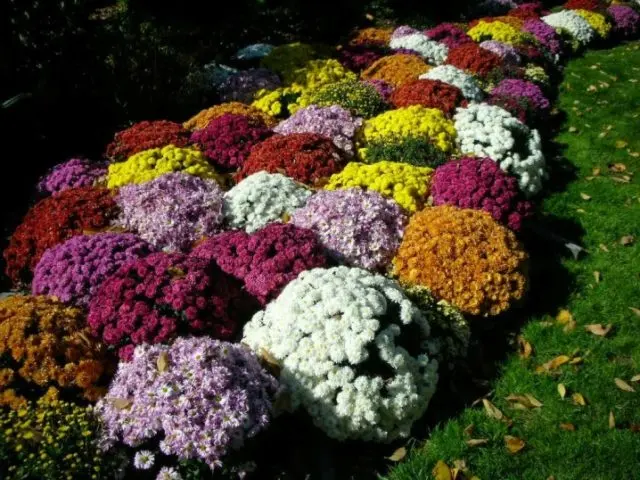
A multi-colored river of spray flowers is a great way to zone a site
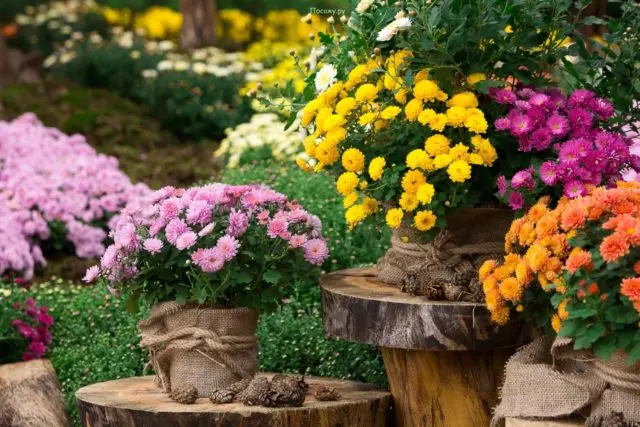
Plants, as decoration elements, can be used even in a pot
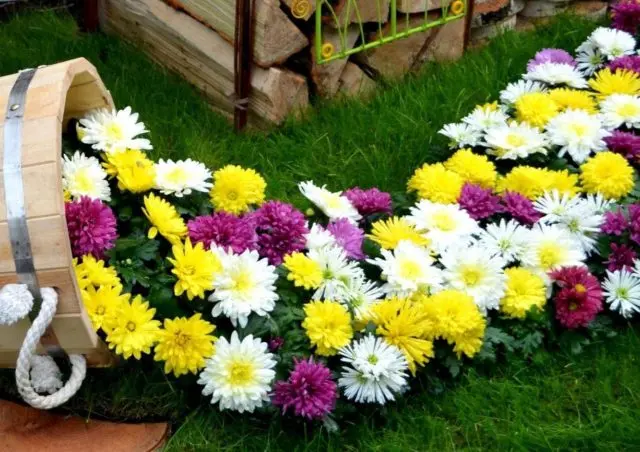
Non-standard design move – a stream of flowers will look great at the entrance to the garden
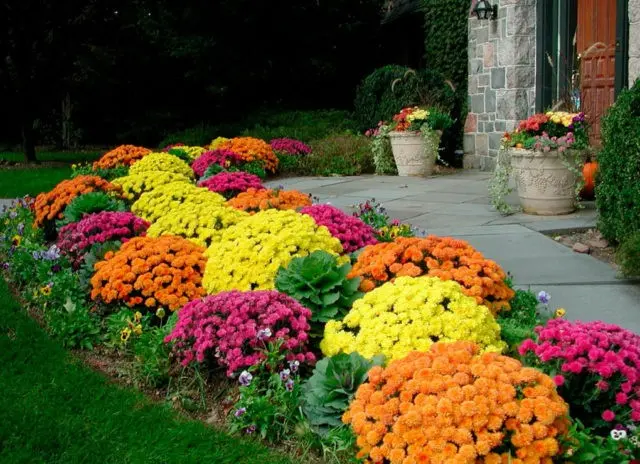
A multi-colored border will be a great way to highlight the path to the house.
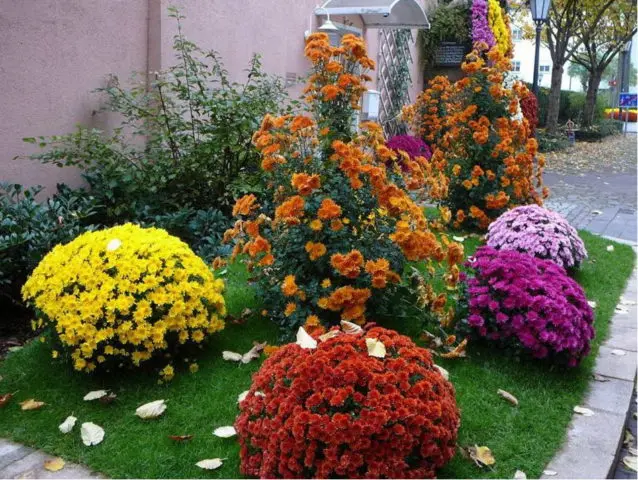
A flowerbed with bushes is a classic solution for decorating a site or a separate corner in a park
Conclusion
Bush chrysanthemum in the skillful hands of a garden designer can become a real highlight of a personal plot. The variety of shapes and colors allows you to surprisingly accurately select colors and compose compositions. Bush chrysanthemum is an excellent way to prolong summer and keep a lot of bright colors in the garden until the very cold.










